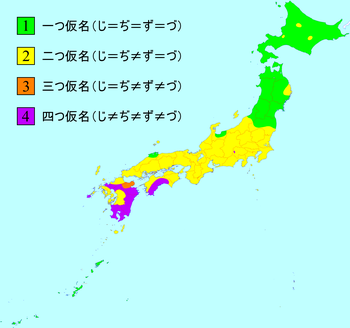Yotsugana
- View a machine-translated version of the Japanese article.
- Machine translation, like DeepL or Google Translate, is a useful starting point for translations, but translators must revise errors as necessary and confirm that the translation is accurate, rather than simply copy-pasting machine-translated text into the English Wikipedia.
- Consider adding a topic to this template: there are already 1,061 articles in the main category, and specifying
|topic=will aid in categorization. - Do not translate text that appears unreliable or low-quality. If possible, verify the text with references provided in the foreign-language article.
- You must provide copyright attribution in the edit summary accompanying your translation by providing an interlanguage link to the source of your translation. A model attribution edit summary is
Content in this edit is translated from the existing Japanese Wikipedia article at [[:ja:四つ仮名]]; see its history for attribution. - You may also add the template
{{Translated|ja|四つ仮名}}to the talk page. - For more guidance, see Wikipedia:Translation.

 |
| Japanese writing |
|---|
| Components |
| Kanji |
| Kana
|
| Typographic symbols
|
| Uses |
| Transliteration |
|
|
Yotsugana (四つ仮名, literally "four kana") are a set of four specific kana, じ, ぢ, ず, づ (in the Nihon-shiki romanization system: zi, di, zu, du), used in the Japanese writing system. They historically represented four distinct voiced morae (syllables) in the Japanese language. However, most dialects, such as Standard Japanese-speakers, have undergone mergers and now pronounce two sounds.
Modern sound usage in various dialects
Most of the far northern dialects (Tōhoku dialects and Hokkaidō) and far southern dialects (notably Okinawan Japanese) and the Ryukyuan languages (the other Japonic languages) have also mostly merged the four sounds to one sound. However, a few dialects, mainly around Shikoku and Kyushu in the southwest, still distinguish three or even all four sounds.
In the current Tokyo dialect, the base of the modern standard language, as well as in the widely spoken Kansai dialect, only two sounds are distinguished, as is represented in the Hepburn (ji, ji, zu, zu) and Kunrei (zi, zi, zu, zu) romanization systems.
Modern kana usage
The spelling differences between the four kana were retained well into the mid-20th century, long after the merger of the different sounds that they had represented. Two distinct morae remain in most dialects of the mainland, such as in Tokyo.
Shortly after World War II ended, the discrepancy between kana orthography and pronunciation was rectified as part of a general orthographic reform, the Gendai Kanazukai, or modern kana orthography. Under the new orthographic rules, only the two kana じ zi and ず zu are to be used, with two notable exceptions:
- When a word exhibits sequential voicing, or rendaku, as a result of compounding, a second morpheme that would otherwise begin with the kana つ tu or ち ti in isolation (神無月 かんなづき kannaduki for which 月 in isolation is written つき tuki).
- When the kana つ tu or ち ti is repeated and voiced in a word (続く つづく tuduku).
An exception was permitted for regions that pronounced the four kana as three or four distinct sounds. After a 1986 update to the Gendai Kanazukai, the exception was replaced with a statement that the unified spelling was to be primarily used, but etymologically-correct spellings would still be permitted.
Modern regional variants
The following table shows some of the differentiations among yotsugana characters expressed in regional dialects across Japan:
| Variants | ぢ di | じ zi | づ du | ず zu |
|---|---|---|---|---|
| Tokyo (standard) | [d͡ʑi] ~ [ʑi] | [d͡zɯᵝ] ~ [zɯᵝ] | ||
| North Tohoku, Izumo[1] | [d͡ʑi] | |||
| South Tohoku | [d͡zɯᵝ] | |||
| Kōchi (Hata, Tosa)[1] | [di] ~ [dᶻi] | [ʑi] | [dɯᵝ] ~ [dᶻɯᵝ] | [zɯᵝ] |
| Kagoshima | [d͡ʑi] | [ʑi] | [d͡zɯᵝ] | [zɯᵝ] |
| Okinawa | [d͡ʑi] | |||
References
- ^ a b Jeroen van de Weijer, Kensuke Nanjo, Tetsuo Nishihara (2005). Voicing in Japanese. Walter de Gruyter. p. 150. ISBN 9783110197686.
{{cite book}}: CS1 maint: multiple names: authors list (link)









